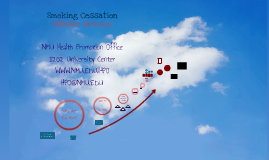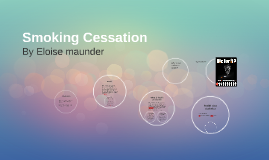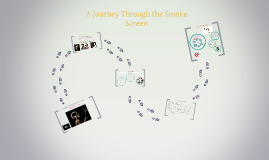Smoking Cessation
Transcript: In the United States, cigarette smoking results in more deaths than HIV/AIDS, drug abuse, homicide, suicide, automobile accidents, and fire COMBINED. When you are near a smoker, you inhale the same dangerous chemicals as the smoker through SECONDHAND SMOKE (Tobacco, 2013). Cigarettes contain the addictive drug nicotine, which is why when smokers try to quit they experience withdraw symptoms such as irritability, attention difficulties, increase appetite, and sleep disturbances D'Amico, D., & Barbarito, C. (2012). -Tobacco Free Arizona -The American Heart Association -Healthy People 2020 -The Respiratory Health Association Promotion of exercise, healthy eating, and stress management Smoking is known to affect most organs and functions of the body Reasons People Start Smoking... Smoking Cessation Each day in the US approximately 3,800 young people under the age of 18 smoke their first cigarette, and an estimated thousand in that age group become daily cigarette smokers. AL-Doghether, M. (2004). The Behavioral Interventions for Smoking Cessation. Asia Pacific Family Medicine, 319-28. Health activitiesD'Amico, D., & Barbarito, C. (2012). Health and physical assessment in nursing (2nd ed.). Upper Saddle River, NJ: Pearson. Drug facts: Cigarettes and other tobacco products. (2012, December). Retrieved February 3, 2013, from National institute on drug abuse: The science of drug abuse and addiction website: http://www.drugabuse.gov/publications/drugfacts/cigarettes-other-tobacco-products Galloway, M. (2012). Smoking cessation What works?. Practice Nurse, 42(15), 16-20. PreventionGanley, B. J., & Rosario, D. I. (2013). The smoking attitudes, knowledge, intent, and behaviors of adolescents and young adults: Implications for nursing practice. Journal of Nursing Education and Practice, 3(1), 40. Retrieved from http://search.proquest.com/docview/1081692956?accountid=7374Lynes, D., & Lynes, A. (2012). Strategies to help adolescents stop smoking. Nursing Times, 108, 12-4. Retrieved from http://search.proquest.com/docview/1038838873?accountid=7374Medicines to help you quit smoking. (2013). Retrieved fromhttp://www.heart.org/HEARTORG/ GettingHealthy/QuitSmoking/QuittingSmoking/Medicines-To-Help-You-Quit-Smoking_UCM_307921_Article.jspParents Who Smoke Influence Smoking Among Teens. (2009, January 29). RetrievedJanuary 30, 2013,from Red Orbit website: http://www.redorbit.com/news/health/1630924/ parents_who_smoke_influence_smoking_among_teens/Quit Smoking. (2013). Retrieved from Respiratory Health Association website: http://www.lungchicago.org/quit-smoking/Sherman, E. J., & Primack, B. A. (2009). What Works to Prevent Adolescent Smoking? A Systematic Review of the National Cancer Institute's Research-Tested Intervention Programs. Journal Of School Health, 79(9), 391-399.Smoking: Peer Pressure. (n.d.). Retrieved January 30, 2013, from PBSkids.com website:http://pbskids.org/itsmylife/body/smoking/article4.htmlTobacco Advertising and Promotion. (n.d.). Retrieved January 30, 2013, from American Lung Association website: http://www.lung.org/ Tobacco facts and figures. (2012). Retrieved February 3, 2013, from Be tobacco free website: http://betobaccofree.hhs.gov/about-tobacco/facts-figures/index.htmlTobacco Free Arizona. (2012). Retrieved from http://azdhs.gov/tobaccofreeaz/partners/partners.htmlYouth and tobacco use. (2012, November 15). Retrieved January 30, 2013, from Centers for disease control and prevention website: http://www.cdc.gov/tobacco/data_statistics/fact_sheets/youth_data/tobacco_use/index.htm -Heart -Lungs -Kidneys -Brain -Breathing -Blood Pressure How to QUIT! The Truth about SMOKING... -Prescription Drugs (Bupropion or Chantix) -Use of nicotine replacements (gum, lozenges, or patches) -Stress relief programs (meditation) -Self help books, pamphlets, audio books, websites, and phone hotlines -Group therapy or individual counseling (Galloway, 2012) Health Consequences of Smoking ...and can lead to... -Chronic Bronchitis and Emphysema -Lung Cancer and Cancer of the Mouth -Increase heart rate -Shortness of Breath -Increased risk of stroke and heart attack -Infections Adolescent Smoking -Smoking by parents, or guardians -Social Media -Use of tobacco by peers and siblings -Low socioeconomic status -Low self esteem/self image -Accessibility/Availability/Cost -Stress -Alcohol Approximately 90% of all smokers start before the age of 18, and the average age for a new smoker is 13. Resources Education Resources Marketing (Ganley & Rosario, 2013) (Lynes & Lyne, 2012) Health Promotion (Quitting smoking statistics, 2012). Peer Pressure Community and National Resources Tobacco Companies Children are about 3.6 times more likely to start smoking cigarettes if their parents smoke (Sherman, 2009). SECONDHAND SMOKE A recent statistic states, that only 7% of people that try to quit on the first time succeed Kelsey Doody, Kevy Mortensen, Claire Greenfield, Jeff Gonzales, Dealla Fakhouri

















